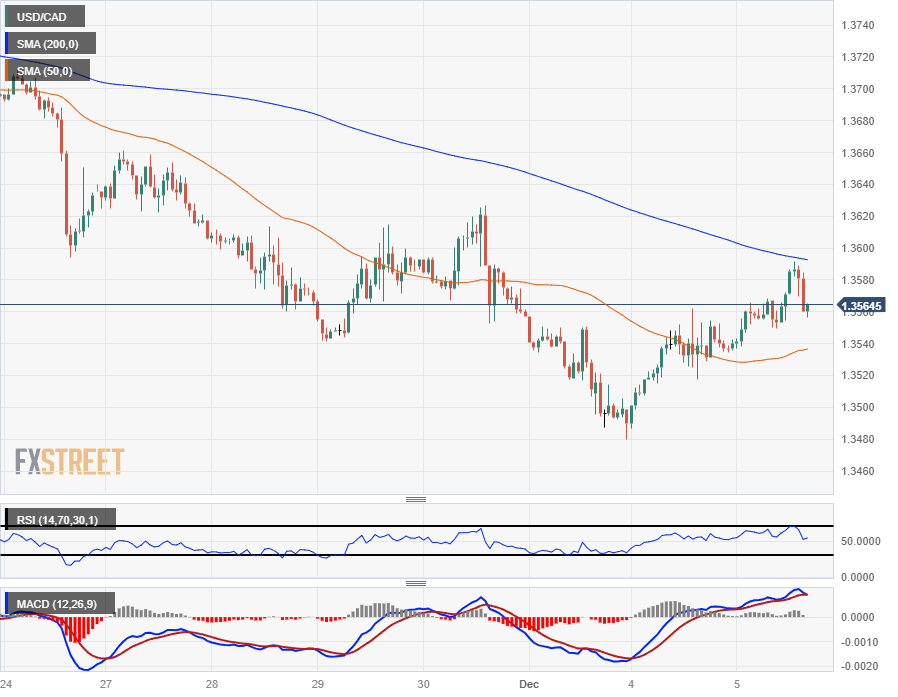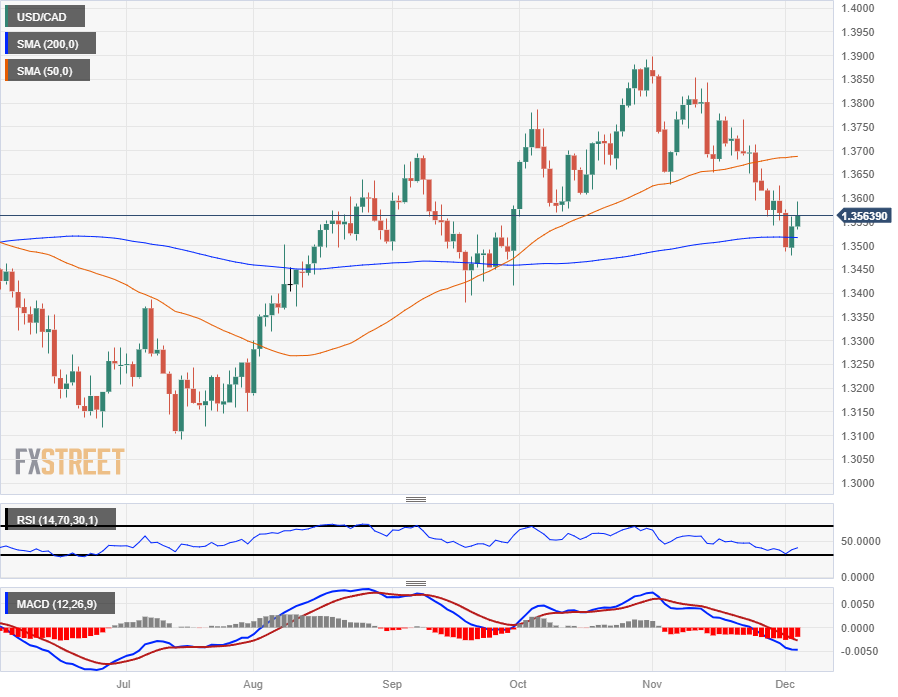- Analytics
- News and Tools
- Market News
- Canadian Dollar looks for Tuesday recovery after early declines
Canadian Dollar looks for Tuesday recovery after early declines
- The Canadian Dollar sees new lows but seeks a foothold in the American session.
- Bank of Canada rate call on Wednesday to draw CAD traders’ attention.
- Shifts in risk appetite have the markets moving in and out of the safe havens.
The Canadian Dollar (CAD) eased back further on Tuesday before making a late rebound on the day, shedding a third of a percent against the US Dollar (USD) before paring back the day’s declines to a more manageable level. Market sentiment rattled through early Tuesday trading after Moody’s downgraded China’s credit outlook, sending the US Dollar broadly higher on the day.
The Bank of Canada (BoC) makes an appearance on Wednesday with the Canadian central bank’s latest rate call, and money markets expect another rate hold with dovish tweaks from the BoC.
Crude Oil markets are mixed on Tuesday as West Texas Intermediate (WTI) slumps through the day before a recovery back to the high side during the American market session.
Daily Digest Market Movers: Canadian Dollar tracks Crude Oil in both directions as markets weigh risk positioning
- Canadian Dollar traders are sidelined ahead of the BoC’s Wednesday rate call, US Dollar flows drive the bids.
- Money markets expect the BoC to stand pat on interest rates this week, though some dovish tweaks to the Canadian central bank’s talking points are expected.
- BoC overnight rate to remain at 5%, BoC Governor Tiff Macklem expected to omit comments about inflationary risks and focus on weaker Q3 performance instead.
- Broad-market sentiment took a hit early on Tuesday after Moody’s downgraded China’s credit outlook from stable to negative, pushing markets into the US Dollar and forcing down the Canadian Dollar as a knock-on effect.
- US data is mixed on Tuesday with the Institute for Supply Management’s (ISM) Services Purchasing Managers Index (PMI) coming in better than expected, while the JOLTS Job Openings for October printed less available job postings than expected.
- The US job market remains tight with the JOLTS posting its lowest job openings in over two and a half years.
- Crude Oil markets are mixed on the day with fossil fuel bids under pressure from declining global demand and rising crude stocks.
- Russia, UAE to discuss achieving broader unity on OPEC production cuts, backstopping Crude Oil bids on Tuesday by preventing further declines.
Canadian Dollar price today
The table below shows the percentage change of Canadian Dollar (CAD) against listed major currencies today. Canadian Dollar was the weakest against the Japanese Yen.
| USD | EUR | GBP | CAD | AUD | JPY | NZD | CHF | |
| USD | 0.41% | 0.27% | 0.22% | 0.94% | -0.08% | 0.48% | 0.33% | |
| EUR | -0.41% | -0.14% | -0.17% | 0.53% | -0.49% | 0.07% | -0.07% | |
| GBP | -0.28% | 0.15% | -0.03% | 0.67% | -0.33% | 0.22% | 0.06% | |
| CAD | -0.23% | 0.18% | 0.02% | 0.68% | -0.29% | 0.23% | 0.10% | |
| AUD | -0.93% | -0.52% | -0.67% | -0.71% | -1.01% | -0.46% | -0.61% | |
| JPY | 0.11% | 0.44% | 0.32% | 0.28% | 1.00% | 0.56% | 0.39% | |
| NZD | -0.48% | -0.06% | -0.20% | -0.24% | 0.46% | -0.56% | -0.15% | |
| CHF | -0.33% | 0.08% | -0.06% | -0.10% | 0.61% | -0.42% | 0.12% |
The heat map shows percentage changes of major currencies against each other. The base currency is picked from the left column, while the quote currency is picked from the top row. For example, if you pick the Euro from the left column and move along the horizontal line to the Japanese Yen, the percentage change displayed in the box will represent EUR (base)/JPY (quote).
Technical Outlook: Canadian Dollar splits the rally, planted in Tuesday’s midrange
The Canadian Dollar (CAD) is stuck somewhere in the middle on Tuesday, down a fifth of a percent against the US Dollar (USD) and a third of a percent against the Japanese Yen (JPY). On the upside, the Loonie outperformed the Antipodeans, up two-thirds of a percent and a quarter of a percent against the Aussie (AUD) and the Kiwi (NZD), respectively.
The USD/CAD set a new high for the week near 1.3590 before the Canadian Dollar pared away some of the day’s losses to land near 1.3560, and intraday price action remains capped by the 200-hour Simple Moving Average (SMA) dropping through the 1.3600 handle.
The USD/CAD is still within shooting range of a technical bounce from the 200-day SMA just north of the 1.3500 handle, and a continued recovery from the US Dollar will see the pair taking a run at the 50-day SMA near 1.3700.
On the downside, a break below the week’s bottom bids of 1.3480 will see bearish momentum accelerate, and bears’ sights will be set on 2023’s lows just beyond 1.3100.
USD/CAD Hourly Chart

USD/CAD Daily Chart

Canadian Dollar FAQs
What key factors drive the Canadian Dollar?
The key factors driving the Canadian Dollar (CAD) are the level of interest rates set by the Bank of Canada (BoC), the price of Oil, Canada’s largest export, the health of its economy, inflation and the Trade Balance, which is the difference between the value of Canada’s exports versus its imports. Other factors include market sentiment – whether investors are taking on more risky assets (risk-on) or seeking safe-havens (risk-off) – with risk-on being CAD-positive. As its largest trading partner, the health of the US economy is also a key factor influencing the Canadian Dollar.
How do the decisions of the Bank of Canada impact the Canadian Dollar?
The Bank of Canada (BoC) has a significant influence on the Canadian Dollar by setting the level of interest rates that banks can lend to one another. This influences the level of interest rates for everyone. The main goal of the BoC is to maintain inflation at 1-3% by adjusting interest rates up or down. Relatively higher interest rates tend to be positive for the CAD. The Bank of Canada can also use quantitative easing and tightening to influence credit conditions, with the former CAD-negative and the latter CAD-positive.
How does the price of Oil impact the Canadian Dollar?
The price of Oil is a key factor impacting the value of the Canadian Dollar. Petroleum is Canada’s biggest export, so Oil price tends to have an immediate impact on the CAD value. Generally, if Oil price rises CAD also goes up, as aggregate demand for the currency increases. The opposite is the case if the price of Oil falls. Higher Oil prices also tend to result in a greater likelihood of a positive Trade Balance, which is also supportive of the CAD.
How does inflation data impact the value of the Canadian Dollar?
While inflation had always traditionally been thought of as a negative factor for a currency since it lowers the value of money, the opposite has actually been the case in modern times with the relaxation of cross-border capital controls. Higher inflation tends to lead central banks to put up interest rates which attracts more capital inflows from global investors seeking a lucrative place to keep their money. This increases demand for the local currency, which in Canada’s case is the Canadian Dollar.
How does economic data influence the value of the Canadian Dollar?
Macroeconomic data releases gauge the health of the economy and can have an impact on the Canadian Dollar. Indicators such as GDP, Manufacturing and Services PMIs, employment, and consumer sentiment surveys can all influence the direction of the CAD. A strong economy is good for the Canadian Dollar. Not only does it attract more foreign investment but it may encourage the Bank of Canada to put up interest rates, leading to a stronger currency. If economic data is weak, however, the CAD is likely to fall.
© 2000-2024. All rights reserved.
This site is managed by Teletrade D.J. LLC 2351 LLC 2022 (Euro House, Richmond Hill Road, Kingstown, VC0100, St. Vincent and the Grenadines).
The information on this website is for informational purposes only and does not constitute any investment advice.
The company does not serve or provide services to customers who are residents of the US, Canada, Iran, The Democratic People's Republic of Korea, Yemen and FATF blacklisted countries.
Making transactions on financial markets with marginal financial instruments opens up wide possibilities and allows investors who are willing to take risks to earn high profits, carrying a potentially high risk of losses at the same time. Therefore you should responsibly approach the issue of choosing the appropriate investment strategy, taking the available resources into account, before starting trading.
Use of the information: full or partial use of materials from this website must always be referenced to TeleTrade as the source of information. Use of the materials on the Internet must be accompanied by a hyperlink to teletrade.org. Automatic import of materials and information from this website is prohibited.
Please contact our PR department if you have any questions or need assistance at pr@teletrade.global.















